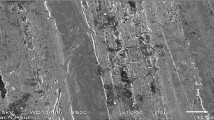Abstract
Influence of machining parameters, viz., spindle speed, depth of cut and feed rate, on the quality of surface produced in CNC end milling is investigated. In the present study, experiments are conducted for three different workpiece materials to see the effect of workpiece material variation in this respect. Five roughness parameters, viz., centre line average roughness, root mean square roughness, skewness, kurtosis and mean line peak spacing have been considered. The second-order mathematical models, in terms of the machining parameters, have been developed for each of these five roughness parameters prediction using response surface method on the basis of experimental results. The roughness models as well as the significance of the machining parameters have been validated with analysis of variance. It is found that the response surface models for different roughness parameters are specific to workpiece materials. An attempt has also been made to obtain optimum cutting conditions with respect to each of the five roughness parameters considered in the present study with the help of response optimization technique.
Similar content being viewed by others
References
Benardos PG, Vosniakos GC (2003) Predicting surface roughness in machining: a review. Int J Mach Tools Manuf 43:833–844
Kline WA, Devor RA, Shareef IA (1982) The prediction of surface geometry in end milling. ASME J Eng Ind 104:272–278
Alauddin M, Baradie MA, Hashmi MSJ (1995) Computer-aided analysis of a surface-roughness model for end milling. J Mater Process Technol 55:123–127
Fuh KH, Wu CF (1995) A proposed statistical model for surface quality prediction in end-milling of Al alloy. Int J Mach Tools Manuf 35:1187–1200
Lou MS, Chen JC, Li CM (1998) Surface roughness prediction technique for CNC end milling. J Ind Technol 15(1):1–6
Lou MS, Chen JC (1999) In-process surface roughness recognition system in end-milling operations. Int J Adv Manuf Technol 15:200–209
Yang JL, Chen JC (2001) A systematic approach for identifying optimum surface roughness performance in end-milling. J Ind Technol 17(2):1–8
Mansour A, Abdalla H (2002) Surface roughness model for end milling: a semi- free cutting carbon case hardening steel (EN32) in dry condition. J Mater Process Technol 124:183–191
Benardos PG, Vosniakos GC (2002) Prediction of surface roughness in CNC face milling using neural networks and Taguchi’s design of experiments. Robot Comput Integrated Manuf 18:343–354
Ertekin YM, Kwon Y, Tseng TL (2003) Identification of common sensory features for the control of CNC milling operations under varying cutting conditions. Int J Mach Tools Manuf 43:897–904
Dweiri F, Al-Jarrah M, Al-Wedyan H (2003) Fuzzy surface roughness modeling of CNC down milling of Alumic-79. J Mater Process Technol 133:266–275
Ghani JA, Choudhury IA, Hassan HH (2004) Application of Taguchi method in the optimization of end milling parameters. J Mater Process Technol 145:84–92
Brezocnik M, Kovacic M, Ficko M (2004) Prediction of surface roughness with genetic programming. J Mater Process Technol 157–158:28–36
Wang MY, Chang HY (2004) Experimental study of surface roughness in slot end milling AL2014-T6. Int J Mach Tools Manuf 44:51–57
Oktem H, Erzurumlu T, Kurtaran H (2005) Application of response surface methodology in the optimization of cutting conditions for surface roughness. J Mater Process Technol 170:11–16
Oktem H, Erzurumlu T, Erzincanli F (2006) Prediction of minimum surface roughness in end milling mold parts using neural network and genetic algorithm. Materials and Design 27:735–744
Wang W, Kweon SH, Yang SH (2005) A study on roughness of the micro-end-milled surface produced by a miniatured machine tool. J Mater Process Technol 162–163:702–708
Reddy NSK, Rao PV (2005) Selection of optimum tool geometry and cutting conditions using surface roughness prediction model for end milling. Int J Adv Manuf Technol 26:1202–1210
Ozcelik B, Bayramoglu M (2006) The statistical modeling of surface roughness in high speed flat end milling. Int J Mach Tools Manuf 46:1395–1402
Ryu SH, Choi DK, Chu CN (2006) Roughness and texture generation on end milled surfaces. Int J Mach Tools Manuf 46:404–412
Bagci E, Aykut S (2006) A study of Taguchi optimization method for identifying optimum surface roughness in CNC face milling of cobalt-based alloy (satellite 6). Int J Adv Manuf Technol 29:940–947
Chang CK, Lu HS (2007) Design optimization of cutting parameters for side milling operations with multiple performance characteristics. Int J Adv Manuf Technol 32:18–26
Thomas TR (1999) Rough surfaces (2e). Imperial College Press, London
Montgomery DC (2001) Design and analysis of experiments. Wiley, New York
Minitab User Manual Release 13.2 (2001) Making data analysis easier. MINITAB Inc, State College, PA, USA
Oberg E, Jones FD, Horton HL, Ryffel HH (2000) Machinery’s Hand Book. Industrial Press, New York
ISO 4287:1997 (1997) Geometrical Product Specification (GPS)–Surface Texture: Profile method–terms, Definitions and Surface Texture Parameters. International Organization of Standardization, Geneva
Author information
Authors and Affiliations
Corresponding author
Rights and permissions
About this article
Cite this article
Routara, B.C., Bandyopadhyay, A. & Sahoo, P. Roughness modeling and optimization in CNC end milling using response surface method: effect of workpiece material variation. Int J Adv Manuf Technol 40, 1166–1180 (2009). https://doi.org/10.1007/s00170-008-1440-6
Received:
Accepted:
Published:
Issue Date:
DOI: https://doi.org/10.1007/s00170-008-1440-6




